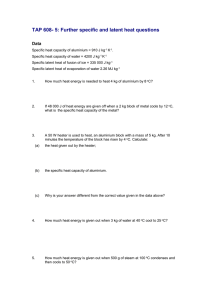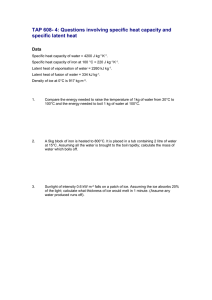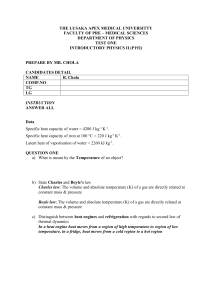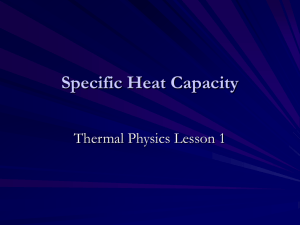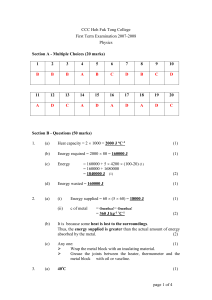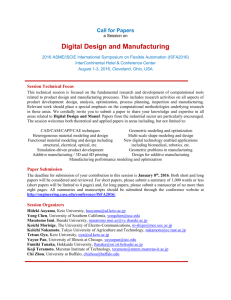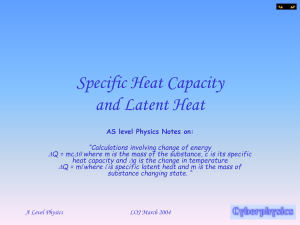questions involving specific and latent heat
advertisement
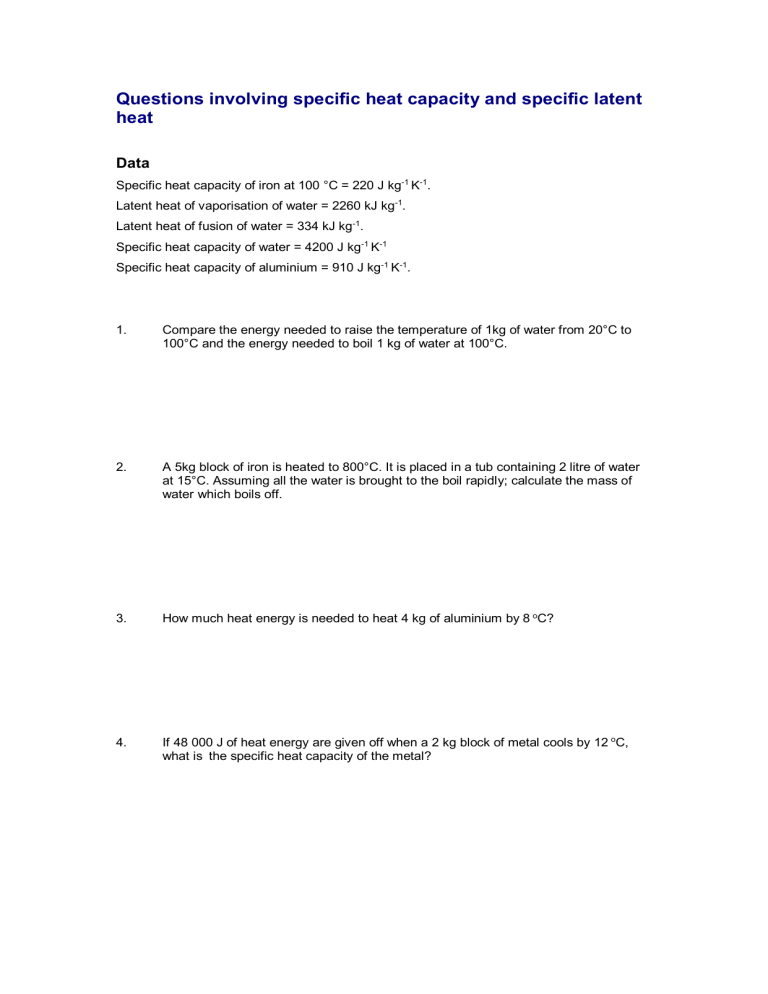
Questions involving specific heat capacity and specific latent heat Data Specific heat capacity of iron at 100 °C = 220 J kg-1 K-1. Latent heat of vaporisation of water = 2260 kJ kg-1. Latent heat of fusion of water = 334 kJ kg-1. Specific heat capacity of water = 4200 J kg-1 K-1 Specific heat capacity of aluminium = 910 J kg-1 K-1. 1. Compare the energy needed to raise the temperature of 1kg of water from 20°C to 100°C and the energy needed to boil 1 kg of water at 100°C. 2. A 5kg block of iron is heated to 800°C. It is placed in a tub containing 2 litre of water at 15°C. Assuming all the water is brought to the boil rapidly; calculate the mass of water which boils off. 3. How much heat energy is needed to heat 4 kg of aluminium by 8 oC? 4. If 48 000 J of heat energy are given off when a 2 kg block of metal cools by 12 oC, what is the specific heat capacity of the metal? 5. A 50 W heater is used to heat, an aluminium block with a mass of 5 kg. After 10 minutes the temperature of the block has risen by 4 oC. Calculate: (a) the heat given out by the heater; (b) the specific heat capacity of aluminium. (c) Why is your answer different from the correct value given in the data above? 6. How much heat energy is given out when 3 kg of water at 40 oC cool to 25 oC? 7. How much heat energy is given out when 500 g of steam at 100 oC condenses and then cools to 50 oC? 8. Why is a scald by steam at 100 oC much more painful than one by water at 100 oC? 9. How long will it take a 50 W heater to melt 2 kg of ice at 0 oC? Practical advice Pupils may need some guidance. Answers and worked solutions Energy required to heat the water = mCθ = 1 4200 80 = 336 kJ 1. Energy required to boil the water = mL = 1 2260 kJ = 2260kJ. So it takes nearly 7 times as much energy to boil the water as to heat it up. 2. Energy given up by the iron in cooling to 100°C (assuming c is constant) = mCθ = 5 700 220 = 770 kJ. To heat 2 litre of water from 15°C to 100°C requires 2 4200 (100-15) = 714 kJ. This leaves 770 - 714 = 56 kJ to boil some of the water. Mass of water boiled away = E/L = 56 / 2260 = 0.025 kg. 3. Energy = mCθ = 4 1200 8 = 38400 J 4. Specific heat capacity = energy / (m θ) = 48000 / (2 12) = 200 J kg-1 K-1 5. (a) Output energy = power x time = 50 10 60 = 30,000 J (b) Specific heat capacity = energy/ (m θ) = 30000 / (5 4) = 1500 J kg-1 K-1 (c) Heat loss to the surroundings, so the energy retained by the metal is less than 30,000, so the value of C should be lower. 6. Heat energy given out = mCθ = 3 4200 (40 – 25) = 189,000 J= 189 kJ 7. Energy in condensing =mL = 0.5 2260000 = 1,130,000 J Energy during cooling = mCθ = 0.5 4200 50 = 105,000 J Total energy given out = 1,130,000 + 105 000 = 1,235,000 J =1,235 kJ 8. Because it has to condense first before cooling so giving out a large amount of latent heat. (Better students will give a sample calculation, see the worked example) 9. Power x time = mL so time = mL/power = 2 335000 / 50 = 670000 / 50 = 13400 s = 223 min = 3.7 hours = 3 hrs 43 minutes (Assumes no heat lost to the surroundings and the water remains at 0 oC.)
